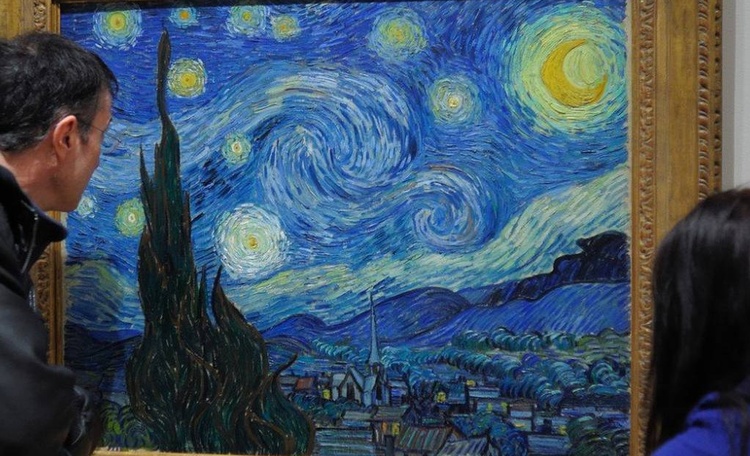
Analysis and meaning of Van Gogh's Starry Night painting
The painting The Starry Night, by Vincent van Gogh, was painted in 1889. It is an oil on canvas, measuring 74 cm X 92 cm, and is located at the Museum of Modern Art in New York (MoMA).
The painting depicts the landscape from the artist's bedroom window while he was in the Saint-Rémy-de-Provence asylum, and is considered one of the Dutch artist's most significant works.
Interpretation and context
Vincent van Gogh painted this painting when he was in the Saint-Rémy-de-Provence asylum, where he voluntarily admitted himself in 1889. Van Gogh had a troubled emotional life, suffering from depression and psychotic episodes.
During the time he was hospitalized he carried out several studies of places in the hospital, such as the corridor and the entrance. His departures were controlled, which left him with limited themes for painting.
At the hospital, Van Gogh had access to two cells: one where he slept, and another on the ground floor, where he could paint. The Starry Night is the view from the room he slept in, just before sunrise. The painter could not complete his paintings in this room, but he had charcoal and paper, which he used to make sketches and later finish the works.
Van Gogh was a post-impressionist and was considered one of the pioneers of modern art. We can see in his works a representation of the world, with strong brushstrokes, but almost no abstraction.
The painting The Starry Night is considered one of Van Gogh's most important, as it contains some small abstractions, which would become essential material for modernism.
Also take the opportunity to read the article Van Gogh's fundamental works and his biography.
Analysis: main elements of the work
This painting is one of Van Gogh's most important. In it, the artist conveys his agitated psychological state through the movement of his brushstrokes and a dynamism previously unheard of.
The use of spirals
The spirals are the first thing that catches your eye in this painting. The quick clockwise strokes give a sense of depth and movement to the sky.
brushstrokes
These spirals are characteristic of Van Gogh's works from that period. With short movements of the brush, the artist constructs a restless sky, revealing his own mental disturbances and drawing an unusual portrait of the sky.
The village
The small village represented in Van Gogh's painting was not part of the landscape seen from his room.
village
Some critics believe that it is a representation of the village in which the painter spent his childhood. Others believe it to be the village of Saint-Rémy.
For all intents and purposes, the village is an insertion made by the artist, being an imagined component that may have been included as a nostalgic memory of his childhood and youth in Holland.
The points of light in the houses relate to the stars in the sky, creating a dialogue between humanity and the grandeur of the milky way.
The cypress
Cypress is a common element in Van Gogh's works. This tree is associated with death in several European cultures. They were used in Egyptian sarcophagi and Roman coffins.
The cypress tree became common for decorating cemeteries and is almost always related to the end of life.
cypress
For Van Gogh, the interest in cypress trees also has a formal, as well as symbolic, character. The painter greatly appreciated the unusual shapes that the cypress presents and its fluidity.
The beautiful movements that this tree makes are represented in this painting, and can also be interpreted as huge flames that dance with the wind.
The stars
The stars are one of the most important elements of the board. In addition to their plastic beauty, they are representative as they demonstrate great abstraction.
stars
At first, Van Gogh was not satisfied with the painting. For him, the stars were too big. He says he was carried away by abstractionist ideas when composing large stars.
Interpretation of the work
This work by Vincent van Gogh is a landmark in the history of art. Its plastic beauty is remarkable and the elements that compose it show the work of a mature artist.
Many critics consider the painting a milestone in Van Gogh's career, even though they had no appreciation for the painter when it was made.
The painting is very expressive, the view of the turbulent night sky with the spirals is striking and contrasts with the calm of the small village just below the lines of the hills.
A cypress tree that rises vertically takes the front of the painting, like a prominent figure in the middle of the landscape. Next to it, the church tower also projects upwards, but in a slightly more timid way. Both project a connection between earth and sky. These are the two vertical elements in this Van Gogh painting.


- July 12, 2025
Gallery of Illustration by Xoana Herrera from Argentina

- July 12, 2025
Gallery of Illustration by Justyna Stasik from Poland

- July 12, 2025
Gallery of Typographic Posters by Li Xu – China

- July 11, 2025
Works by Six Latin American Artists

- July 11, 2025
IdN Magazine Volume 21, No.4 : Pattern Special

- July 11, 2025
Gallery of Posters by Daniel Warner from USA

- July 11, 2025
YEMEN


- July 10, 2025
The Evolution of Graphic Design from Ty…

- July 10, 2025
How Digital Artists Collaborate with Ar…

- July 09, 2025
The Value of Art in Education

- July 09, 2025
Art as a Reflection of Society

- July 08, 2025
The history of Bolivian art

- July 08, 2025
Protecting Art in the Age of Artificial…

- July 04, 2025
Graphic Design and Creating Iconic Bran…

- July 04, 2025
Photography as a Tool for Telling Histo…

- July 03, 2025
Painting and abstract art: differences …

- July 02, 2025
The Best Software for Digital Art and G…

- July 01, 2025
How Digital Artists Collaborate with Ar…

- July 01, 2025
Reflections of Digital Art in Different…

- June 30, 2025
Crítica de Obras Artísticas Criadas por…

- June 30, 2025
What are Plastic Arts?

- June 30, 2025
Images Against Silence: Artists Who Cha…

- June 29, 2025
History of Art Photography in the 20th …

- June 28, 2025
The 11 types of art and their meanings

- June 28, 2025
Contemporary Art is postmodern art

- June 26, 2025
Graphic Design, Art, and Technology: Wh…

- June 25, 2025
Graphic Design and Modern Content Creat…

- August 29, 2023
The history of Bolivian art

- February 19, 2024
Analysis and meaning of Van Gogh's Star…

- January 28, 2024
Culture and Art in Argentina

- September 25, 2023
What is the importance of art in human …

- September 23, 2023
What is paint?

- August 10, 2023
14 questions and answers about the art …

- August 30, 2023
First artistic manifestations

- August 23, 2023
The 11 types of art and their meanings

- January 12, 2024
10 most beautiful statues and sculpture…

- September 23, 2023
Painting characteristics

- September 23, 2023
History of painting

- August 16, 2023
The 15 greatest painters in art history

- April 06, 2024
History of visual arts in Ecuador

- March 26, 2024
The importance of technology in art1

- January 31, 2024
Examples of Street Art – Urban Art

- January 20, 2024
What is the relationship between art an…

- March 26, 2024
Cultural identity and its impact on art…

- April 07, 2024
Graffiti in Latin American culture

- October 21, 2023
Contemporary art after the Second World…

- August 25, 2024
A Comprehensive Analysis of the Cartoon…

- February 19, 2024
Analysis and meaning of Van Gogh's Star…

- August 13, 2023
9 Latino painters and their great contr…

- August 10, 2023
14 questions and answers about the art …

- August 29, 2023
The history of Bolivian art

- January 28, 2024
Culture and Art in Argentina

- August 23, 2023
The 11 types of art and their meanings

- November 06, 2023
5 Latin American artists and their works

- August 27, 2023
15 main works of Van Gogh

- September 23, 2023
Painting characteristics

- September 23, 2023
What is paint?

- September 25, 2023
What is the importance of art in human …

- December 18, 2023
10 iconic works by Oscar Niemeyer, geni…

- August 30, 2023
First artistic manifestations

- January 20, 2024
What is the relationship between art an…

- March 26, 2024
Cultural identity and its impact on art…

- January 12, 2024
10 most beautiful statues and sculpture…

- October 30, 2023
Characteristics of Contemporary Art

- August 22, 2023
What are Plastic Arts?

- April 16, 2024
The most important painters of Latin Am…

- August 24, 2023


